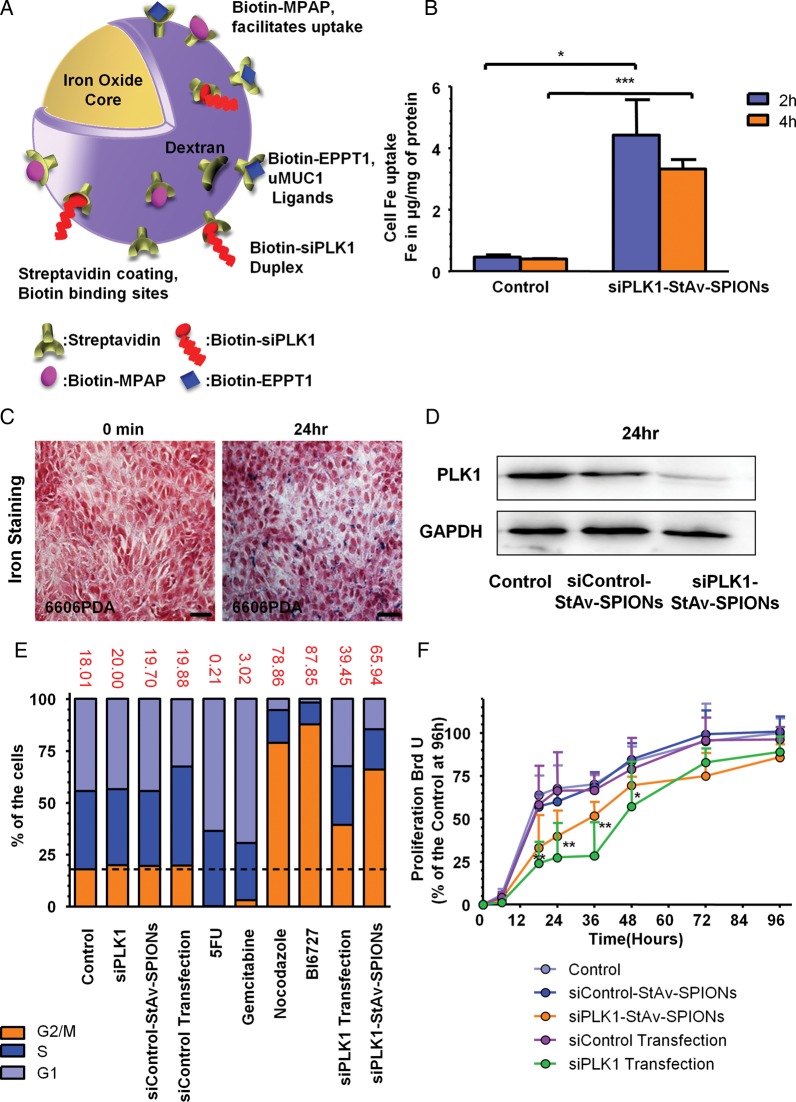Figure 1.
siPLK1-StAv-superparamagnetic iron oxide nanoparticles (SPIONs) are efficacious in silencing PLK1 and reducing tumour cell proliferation in vitro. (A) Schematic representation of siPLK1-coupled streptavidin-conjugated dextran-coated SPIONs (siPLK1-StAv-SPIONs) conjugated to the membrane translocation peptide for mediating transportation to the cytoplasm (myristoylated polyarginine peptides (MPAP)), the underglycosylated MUC1 (uMUC1)-specific peptide (EPPT1) and siRNA molecules targeting PLK1 (siPLK1). (B) Quantitative analysis of the uptake of siPLK1-StAv-SPIONs into tumour cells was estimated by iron content in cell lysates and showed significant uptake of iron in cells on 2 and 4 h incubation. Data represent mean±SD (n=3, Mann–Whitney U test, U=0.00, p=0.03 (2 h), U=0.00, p=0.003 (4 h)). (C) Representative images showing uptake of siPLK1-StAv-SPIONs inside 6606PDA tumour cells at 0 and 24 h after incubation with siPLK1-StAv-SPIONs. (D) Immunoblotting of PLK1 revealed a decrease in PLK1 expression after siPLK1-StAv-SPIONs treatment 24 h after siPLK1-StAv-SPIONs treatment corresponding to mismatch control RNAi. (E) The silencing effect of PLK1 by siPLK1-StAv-SPIONs was manifested as the change in the cell cycle of diploid cells analysed using fluorescence activated cell sorting (FACS) analysis. siPLK1-StAv-SPIONs treatment showed stagnancy of the cells in G2/M phase of cell cycle (∼66%) compared with that of control (∼18%). 5-fluorouracil (5-FU) (G1 stagnancy), gemcitabine (G1 stagnancy), nocodazole (G2/M stagnancy) and BI6727 (specific PLK1 small-molecule inhibitor, G2/M stagnancy) served as controls for respective phases of cell cycle. (F) Quantitative estimation of BrdU-positive cell proliferation over a period of 48 h showed a significant decrease in proliferation of the murine pancreatic cancer cell line 6606PDA on treatment of siPLK1-StAv-SPIONs. Data represent mean±SD (n=7–8, Mann–Whitney U test. U=21.00, p=0.27 (6 h), U=6.00, p=0.004 (18 h), U=4.00, p=0.002 (24 h), U=1.00, p=0.0003 (36 h), U=7.50, p=0.02 (48 h), U=15.00, p=0.08 (72 h), U=8.00, p=0.06 (96 h)), ***p<0.001, **p<0.01, *p<0.05.

